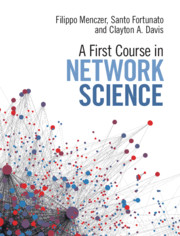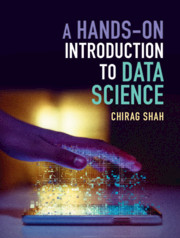Refine search
Actions for selected content:
1835 results in Knowledge Management, Databases and Data Mining

A First Course in Network Science
-
- Published online:
- 05 February 2020
- Print publication:
- 23 January 2020
-
- Textbook
- Export citation

A Hands-On Introduction to Data Science
-
- Published online:
- 01 February 2020
- Print publication:
- 02 April 2020
-
- Textbook
- Export citation
18 - Probabilistic Classification
- from Part Four - Classification
-
- Book:
- Data Mining and Machine Learning
- Published online:
- 07 February 2020
- Print publication:
- 30 January 2020, pp 469-482
-
- Chapter
- Export citation
4 - Graph Data
- from Part One - Data Analysis Foundations
-
- Book:
- Data Mining and Machine Learning
- Published online:
- 07 February 2020
- Print publication:
- 30 January 2020, pp 92-133
-
- Chapter
- Export citation
22 - Classification Assessment
- from Part Four - Classification
-
- Book:
- Data Mining and Machine Learning
- Published online:
- 07 February 2020
- Print publication:
- 30 January 2020, pp 546-586
-
- Chapter
- Export citation
11 - Graph Pattern Mining
- from Part Two - Frequent Pattern Mining
-
- Book:
- Data Mining and Machine Learning
- Published online:
- 07 February 2020
- Print publication:
- 30 January 2020, pp 282-302
-
- Chapter
- Export citation
8 - Itemset Mining
- from Part Two - Frequent Pattern Mining
-
- Book:
- Data Mining and Machine Learning
- Published online:
- 07 February 2020
- Print publication:
- 30 January 2020, pp 219-243
-
- Chapter
- Export citation
9 - Summarizing Itemsets
- from Part Two - Frequent Pattern Mining
-
- Book:
- Data Mining and Machine Learning
- Published online:
- 07 February 2020
- Print publication:
- 30 January 2020, pp 244-260
-
- Chapter
- Export citation
21 - Support Vector Machines
- from Part Four - Classification
-
- Book:
- Data Mining and Machine Learning
- Published online:
- 07 February 2020
- Print publication:
- 30 January 2020, pp 517-545
-
- Chapter
- Export citation
Part Three - Clustering
-
- Book:
- Data Mining and Machine Learning
- Published online:
- 07 February 2020
- Print publication:
- 30 January 2020, pp 332-333
-
- Chapter
- Export citation
Preface
-
- Book:
- Data Mining and Machine Learning
- Published online:
- 07 February 2020
- Print publication:
- 30 January 2020, pp xi-xii
-
- Chapter
- Export citation
5 - Kernel Methods
- from Part One - Data Analysis Foundations
-
- Book:
- Data Mining and Machine Learning
- Published online:
- 07 February 2020
- Print publication:
- 30 January 2020, pp 134-162
-
- Chapter
- Export citation
25 - Neural Networks
- from Part Five - Regression
-
- Book:
- Data Mining and Machine Learning
- Published online:
- 07 February 2020
- Print publication:
- 30 January 2020, pp 637-671
-
- Chapter
- Export citation
13 - Representative-based Clustering
- from Part Three - Clustering
-
- Book:
- Data Mining and Machine Learning
- Published online:
- 07 February 2020
- Print publication:
- 30 January 2020, pp 334-363
-
- Chapter
- Export citation
Contents
-
- Book:
- Data Mining and Machine Learning
- Published online:
- 07 February 2020
- Print publication:
- 30 January 2020, pp v-x
-
- Chapter
- Export citation
2 - Numeric Attributes
- from Part One - Data Analysis Foundations
-
- Book:
- Data Mining and Machine Learning
- Published online:
- 07 February 2020
- Print publication:
- 30 January 2020, pp 29-60
-
- Chapter
- Export citation
Part Two - Frequent Pattern Mining
-
- Book:
- Data Mining and Machine Learning
- Published online:
- 07 February 2020
- Print publication:
- 30 January 2020, pp 217-218
-
- Chapter
- Export citation
27 - Regression Evaluation
- from Part Five - Regression
-
- Book:
- Data Mining and Machine Learning
- Published online:
- 07 February 2020
- Print publication:
- 30 January 2020, pp 720-754
-
- Chapter
- Export citation
Part One - Data Analysis Foundations
-
- Book:
- Data Mining and Machine Learning
- Published online:
- 07 February 2020
- Print publication:
- 30 January 2020, pp 1-2
-
- Chapter
- Export citation
12 - Pattern and Rule Assessment
- from Part Two - Frequent Pattern Mining
-
- Book:
- Data Mining and Machine Learning
- Published online:
- 07 February 2020
- Print publication:
- 30 January 2020, pp 303-331
-
- Chapter
- Export citation
